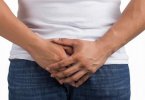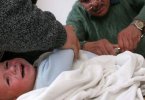Andropause (male menopause), is characterized by a loss of testosterone the hormone that makes men men. Most men see testosterone levels drop as they age. However, some men are impacted more than others are. Diamond says that as many as 25 million American males between ages 40 and 55 are experiencing some degree of male menopause today.
“Male andropause can be very insidious,” explains Dr. Stephen Sinatra, a Manchester, Conn., cardiologist board certified in anti-aging medicine. The loss of testosterone, which can happen to men as young as 35, is gradual, with testosterone levels dropping just 1 percent to 1.5 percent annually. Unlike the precipitous loss of estrogen that women hitting menopause face, the gradual loss of testosterone may take years to exact its mark on men with a host of symptoms not unlike changes menopausal women experience.
Irritability, fatigue, depression, reduced libido and erection problems are hallmark signs of andropause. “I felt like I didn’t want to move,” says Cecil Dorsey of Vernon, Conn. The 68-year-old retired truck driver, who discovered via a blood test nearly four years ago that his testosterone levels dropped, said, “I just didn’t want to be bothered by anything.”
Causes of Andropause
The decrease in testosterone is an important factor in men suspected of having andropause. However, as men age, not only does the body start making less testosterone, but also the levels of another hormone called sex hormone binding globulin (SHBG), which pulls usable testosterone from the blood, begins to increase. SHBG binds some of the available testosterone circulating in the blood. The testosterone that is not bound to the SHBG hormone is called bioavailable testosterone, meaning it is available for use by the body.
Men who experience symptoms associated with andropause have lowered amounts of bioavailable testosterone in their blood. Therefore, tissues in the body that are stimulated by testosterone receive a lower amount of it, which may cause various physical and possibly mental changes in a person such as mood swings or fatigue.
Internal Causes
Andropause is preceded by a condition called Hypogonadotropic hypogonadism. A downturn in the circulation of testosterone should cause the hypothalamus and pituitary gland to trigger a release of brain hormones that stimulate the testicles to ramp up production of testosterone.
Proponents
Proponents of andropause as a distinct condition claim that it is a biological change experienced by men during mid-life, and often compare it to female menopause. Menopause, however, is a complete cessation of reproductive ability caused by the shutting down of the female reproductive system. Andropause is a decline in the male hormone testosterone. This drop in testosterone levels is considered to lead in some cases to erectile dysfunction, diabetes, loss of energy and concentration, depression, and mood swings. While andropause does not cause a man’s reproductive system to stop working altogether, many experience bouts of impotence.
The theory is that andropause is caused by a very gradual testosterone deficiency and an increase in sex hormone-binding globulin (SHBG) that occurs from age 40 onwards. By contrast, women have a more rapid onset of menopause at an average age of 51. Testosterone declines 10% every decade after age 30 (1% per year).
What is known as premature andropause is theorized to occur in males who experience excessive female hormone stimulation through workplace exposure to estrogen. Men who work in the pharmaceutical industry, plastics factories, near incinerators, and on farms that use pesticides are high-risk for early andropause.
Proponents claim that by their mid-50s, about 30 percent of men experience andropause. It is thought that about 5 million American men do not produce adequate testosterone, which leads to early andropause. In Australia, about 1 in every 200 men under the age of 60 and about 1 in every 10 men over 60 have low testosterone. Regardless of location, the most likely males to develop early andropause are those with diabetes, hypertension, and genetic disorders that produce hypogonadism, including Klinefelter’s, Wilson-Turner, and Androgen insensitivity syndromes.
Much of the current popular interest in the concept of andropause has been fueled by the book Male Menopause, written by Jed Diamond, a lay person. According to Diamond’s view, andropause is a change of life in middle-aged men, which has hormonal, physical, psychological, interpersonal, social, sexual, and spiritual aspects. Diamond claims that this change occurs in all men, generally between the ages of 40 and 55, though it can occur as early as 35 or as late as 65. The term “male menopause” may be a misnomer, as unlike women, men’s reproductive systems do not cease to work completely in mid-life; some men continue to father children late into their lives (at age 90 or older). But Diamond claims that, in terms of other life impacts, women’s and men’s experience are somewhat similar phenomena.
The concept of andropause is perhaps more widely accepted in Australia and some parts of Europe than it is in the United States.
Opponents
Many clinicians believe that andropause is not a valid concept. Men can continue to reproduce into old age; their reproductive systems do not stop working completely in midlife, and therefore they do not exhibit the sudden and dramatic drops in hormone levels characteristic of women going through menopause.
Other clinicians are of the opinion that andropause is simply synonymous with hypogonadism or unusually low testosterone levels. There is opposition to the concept of andropause in Europe as well as the U.S.
Some clinicians argue that many of the cited symptoms are not specific enough to warrant describing a new condition. For example, people who are overweight may be misguided into treating a new illness rather than addressing the lifestyle that led to their being overweight. Similarly, energy levels vary from person to person, and for people who are generally inactive, energy levels will automatically be lower overall.
While it is true that active and otherwise healthy men could in theory develop andropause-like symptoms, how common and widespread the phenomenon is, and whether genetics, lifestyle, environment, or a combination of factors are responsible, is not known.
Symptoms and Complications of Andropause
Although symptoms may vary from person to person, common symptoms of men going through andropause include:
- low sex drive
- difficulties getting erections or erections that are not as strong as usual
- lack of energy
- depression
- irritability and mood swings
- loss of strength or muscle mass
- increased body fat
- hot flashes
Complications associated with andropause include an increased risk of cardiovascular problems and osteoporosis
There is Relief for Male Menopause Symptoms
Contrary to popular belief, none of the above male menopause symptomsare just signs of old age. These andropause symptoms may be correctable through bioidentical hormone replacement therapy. It all starts with quick and simple testing that allows a expert anti-aging physician to prescribe a individualized natural bioidentical hormone, nutrition, supplement and fitness program designed to work specifically with your body to correct your symptoms. Live better, longer.
Treating and Preventing Andropause
Replacing testosterone in the blood is the most common treatment for men going through andropause. This treatment may provide relief from the symptoms and help improve the quality of life in many cases. Lifestyle changes such as increased exercise, stress reduction, and good nutrition also help. Your doctor will help you decide if testosterone treatment is right in your situation, as treatment does have risks.
Testosterone is available in a variety of different preparations including skin patches, capsules, gels, and injections. Your doctor will help determine which treatment is best for you and will often consider your lifestyle when making this decision. Follow-up visits with your doctor will be important after the initial treatment begins. At follow-up visits, your doctor will check your response to the treatment and make adjustments, if necessary.
- Skin patches: People who wear a patch containing testosterone receive the hormone through the skin. The patch allows a slow, steady release of testosterone into the blood stream. It is applied once a day to a dry area of skin on the back, abdomen, upper arms, or thighs.
- Testosterone gel: This treatment is also applied directly to the skin, usually on the arms. Because the gel may transfer to other individuals through skin contact, a person must take care to wash the gel from the hands after each application.
- Capsules: Taken twice daily after meals, this is yet another option for testosterone replacement. Men with liver disease, poor liver function, serious heart or kidney disease, or too much calcium in their blood should avoid testosterone capsules.
- Testosterone injections: This treatment involves injections of testosterone (testosterone cypionate* and testosterone enanthate) in the muscle every 2 to 4 weeks. They may cause mood swings due to changes in testosterone levels. Men with severe heart disease, severe kidney disease, or too much calcium in their blood should avoid testosterone cypionate. Men with severe kidney disease should not take testosterone enanthate.
Testosterone should not be taken by any man with prostate or breast cancer. If you have heart disease, are taking some medications such as blood thinners, have an enlarged prostate, or have kidney or liver disease, you will need to discuss with your doctor whether or not testosterone therapy is right for you.





